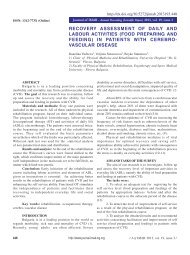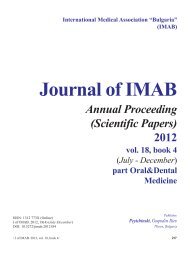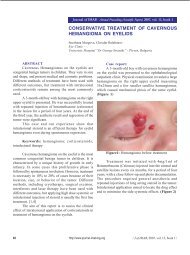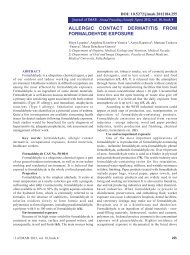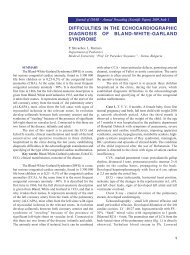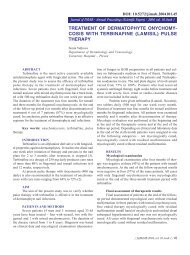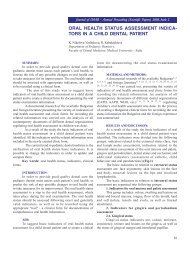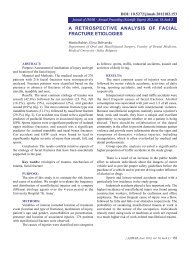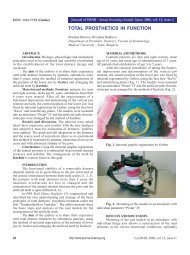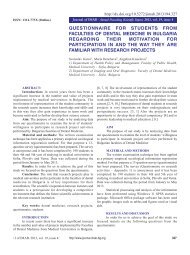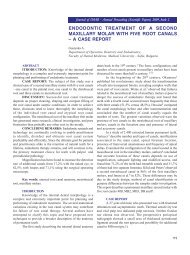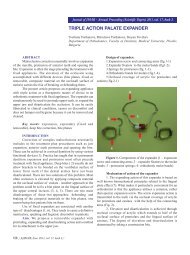olfactory neuroblastoma: clinical presentation and ... - Journal of IMAB
olfactory neuroblastoma: clinical presentation and ... - Journal of IMAB
olfactory neuroblastoma: clinical presentation and ... - Journal of IMAB
Create successful ePaper yourself
Turn your PDF publications into a flip-book with our unique Google optimized e-Paper software.
<strong>Journal</strong> <strong>of</strong> <strong>IMAB</strong> - Annual Proceeding (Scientific Papers) 2005, vol. 11, book 1<br />
OLFACTORY NEUROBLASTOMA: CLINICAL<br />
PRESENTATION AND MANAGEMENT<br />
Boyko Stamenov, Plamen Tzvetanov, Verginia Simeonova, M. Nikolova * , Philip<br />
Philipov<br />
Department <strong>of</strong> Neurology <strong>and</strong> Neurosurgery,<br />
*<br />
Department <strong>of</strong> Pathology<br />
University Hospital <strong>of</strong> Pleven, Bulgaria<br />
ABSTRACT<br />
Olfactory <strong>neuroblastoma</strong> (ONB) is a rare tumor.<br />
There is greater agreement for separating “<strong>neuroblastoma</strong>like”<br />
forms from tumors arising in the same location <strong>and</strong><br />
manifest morphological <strong>and</strong> immunohistochemical characteristics<br />
<strong>of</strong> neuroendocrine carcinoma.<br />
The aim <strong>of</strong> present study is to describe the typical<br />
<strong>clinical</strong>, histological <strong>and</strong> immunohistochemical findings <strong>of</strong><br />
ONB in 58-year old woman which help us to exclude non-<br />
Hodgkin’s lymphoma <strong>and</strong> endocrine carcinoma.<br />
Key words: <strong>olfactory</strong> <strong>neuroblastoma</strong>, <strong>neuroblastoma</strong><br />
like forms, neuroendocrine carcinoma<br />
Olfactory <strong>neuroblastoma</strong> (ONB) is a rare tumor first<br />
described by the French authors L. Berger et al. in 1924 /<br />
2/. It is a malignant neuroectodermal tumor assumed to<br />
originate from <strong>olfactory</strong> receptor cells high in the <strong>olfactory</strong><br />
plate or in dystopic areas /1/. Most commonly the tumor<br />
is situated in the nasal cavity beyond the middle concha,<br />
<strong>and</strong> its extra<strong>olfactory</strong> localization is seldom /1/. The tumor<br />
growth is usually slow <strong>and</strong> over time infiltration <strong>of</strong><br />
adjacent structures takes place in the direction <strong>of</strong> the<br />
paranasal sinuses, oro-nasopharynx, the base <strong>of</strong> scull <strong>and</strong><br />
even the cerebral frontal lobes. Metastatic spread is locally<br />
to cervical lymph nodes, distally to lungs <strong>and</strong> bones <strong>and</strong><br />
through leptomeninges into the brain /3/.<br />
ONB occurs in a broad age range from 2 to 90 years<br />
without any gender predilection. The age <strong>of</strong> onset is to<br />
some extent correlated with the morphological pattern <strong>of</strong><br />
ONB: tumor showing the more classical neuroblastic Homer-<br />
Wright rossetes tend to arise at an earlier age /4/. Most <strong>of</strong><br />
the tumors are immunoreactive for neuron-specific enolase<br />
(84 – 100%), synaptophysin (64 – 100%) <strong>and</strong> 1/3 <strong>of</strong> the<br />
cases are positive for CK MNF /4/.<br />
CASE REPORT<br />
A 58-year old woman was admitted to the Department<br />
<strong>of</strong> Ear, Nose <strong>and</strong> Throat Diseases with symptoms <strong>of</strong><br />
difficult nose breathing, recurrent bleeding from the right<br />
nostril, strong headache with frontal localization, smell disturbances,<br />
slurry <strong>and</strong> decrease vision with right eye, dyplopia.<br />
Two years before she had been diagnosed with<br />
“Pansinusites polyposa” in another hospital. However, her<br />
complaints persisted <strong>and</strong> became more intensive, especially<br />
for the <strong>of</strong>ten recurrent bleeding from the nostrils. The<br />
patient developed anemic syndrome (normochromic, with<br />
normocytosis). She suffered from arterial hypertension,<br />
diabetes mellitus type II with obesity, diabetic<br />
polyneuropathy, chronic bronchitis.<br />
On examination: BP 160/100, 130/80. Pulse 88. Auscultatory<br />
fenomenon for cor hypertonicum. Lab. tests: Hb<br />
92, (86), 100 after hemotransfusion. Ht - 0.26, Er - 3.2, gluc.<br />
- 8.6, Chol. - 5.6, 3-glic. - 2.2.<br />
Neurological status: Ipsilateral (right-sided) anosmia,<br />
primary optic subatrophy, contralateral praeretinal<br />
haemorrhagiae. Lesion <strong>of</strong> the left VI cran. nerve with dyplopia.<br />
CT description: tumor in the nasal cavity, in the maxillar,<br />
ethmoidal <strong>and</strong> sphenoidal sinuses with destruction <strong>of</strong><br />
the sella turcica.<br />
A bilateral ethmoidectomy was performed in the<br />
Department <strong>of</strong> Ear, Nose <strong>and</strong> Throat Diseases. The surgeon<br />
found out heavy bleeding tumor-like formations with<br />
smooth surface <strong>and</strong> s<strong>of</strong>t texture. No enlargement <strong>of</strong> cervical<br />
<strong>and</strong> subm<strong>and</strong>ibular lymph nodes was established. The<br />
operative <strong>and</strong> postoperative periods were abnormal – with<br />
recurrent heavy bleeding from the nose <strong>and</strong> in the subarachnoid<br />
space 48 hours after the operation. The patient<br />
developed sopor, meningeal symptoms, left sided central<br />
hemiplegia, bilateral Babinsky sign, left Openhaim sign, <strong>and</strong><br />
skew deviation <strong>of</strong> the eyes on the right. After treatment in<br />
the Intensive care dept. the listed symptoms disappeared,<br />
but hemiplegia persisted. CT contrast examination before<br />
discharge showed: tumor persisting in the nasal cavity,<br />
paranasal sinuses, epipharynx <strong>and</strong> cellar region. The subarachnoid<br />
haemorrhage was fully resorpted.<br />
The histological examination <strong>of</strong> the material from the<br />
ethmoidal sinus revealed a polypous formation with oedema<br />
<strong>and</strong> scanty inflammatory infiltration. Only in a small<br />
portion there was an <strong>olfactory</strong> neurogenic tumor. The lightmicroscopic<br />
study <strong>of</strong> the histological slides stained with<br />
24 / J<strong>of</strong><strong>IMAB</strong> 2005 vol. 11, book 1 /
hematoxylin-eosin <strong>and</strong> Van Gieson, demonstrated the<br />
following histological features: cellular neoplasm, composed<br />
<strong>of</strong> small uniform cells with scant fibrillar cytoplasm<br />
<strong>and</strong> dark round nuclei. Tumor cells were arranged in lobules,<br />
containing scattered rosettes <strong>of</strong> Homer-Wright type.<br />
The tumor stroma was scanty <strong>and</strong> presented mainly <strong>of</strong><br />
connective tissue with numerous capillaries. The neoplastic<br />
cells were immunoreactive for both: neuron-specific enolase<br />
(NSE) <strong>and</strong> cytokeratin.<br />
DISCUSSION<br />
The <strong>olfactory</strong> <strong>neuroblastoma</strong> is <strong>of</strong> morphological<br />
interest not only as a rare tumor, but also because it’s diverse<br />
histological appearance, encompassing a spectrum<br />
<strong>of</strong> morphological subtypes. More recently, there has been<br />
greater acceptance for separating “<strong>neuroblastoma</strong>-like”<br />
forms from tumors that arise in the same location <strong>and</strong> manifest<br />
morphological <strong>and</strong> immunohistochemical characteristics<br />
<strong>of</strong> neuroendocrine carcinoma /3/. In the case reported<br />
here, we made the diagnosis on the base <strong>of</strong> typical histological<br />
features <strong>and</strong> immunohistochemical findings, which<br />
help us to exclude non-Hodgkin’s lymphoma <strong>and</strong> endocrine<br />
carcinoma.<br />
We regard that recurrent nasal bleedings leading to<br />
anaemia in combination with visual disturbances must be<br />
very suggestive for <strong>neuroblastoma</strong>. Even routine polypectomy<br />
requires a histological examination, which can be<br />
combined with immunohistochemistry for a more precise<br />
diagnosis. ONB in advanced stages is unable for radical<br />
operative treatment.<br />
REFERENCES<br />
1. Ãîëîâèí Ä. È. Îøèáêè è òðóäíîñòè<br />
ãèñòîëîãè÷åñêîé äèàãíîñòèêè îïóõîëåé.<br />
Ìîñêâà, Ìåäèöèíà, 1982: 120. (in<br />
Russian)<br />
2. Ðàé÷åâ Ð. Áèîïñèÿ - ìîðôîëîãè÷íà<br />
èíòåðïðåòàöèÿ. Ñîôèÿ, Ìåä. è ôèçê.,<br />
1984:66. (in Bulgarian)<br />
3. Kleihues P., Cvenee W. K. World<br />
health organisation classification <strong>of</strong> tumours.<br />
Pathologfy <strong>and</strong> genetics <strong>of</strong> tumours<br />
<strong>of</strong> the nervous system. IARCPress, Lyon,<br />
2000: 150 – 152.<br />
4. Mills S. E., Fechner R. E. The nose,<br />
paranasal sinuses <strong>and</strong> nasopharinx. In:<br />
Sternberg S. S. editor. Diagnostic surgical<br />
pathology, 2 nd ed., New York, Raven press,<br />
1994: 866 – 869.<br />
Address for correspondence:<br />
Assoc. pr<strong>of</strong>. Dr. Boyko Stamenov, PhD<br />
Department <strong>of</strong> Neurology <strong>and</strong> Neurosurgery<br />
University Hospital <strong>of</strong> Pleven<br />
8A, Georgi Kochev Str., 5800 Pleven, Bulgaria<br />
tel.: +359/64/886 280; mobile: +359/888 382 501<br />
E-mail: bb_stamenov@biscom.net<br />
/ J<strong>of</strong><strong>IMAB</strong> 2005, vol. 11, book 1 / 25



